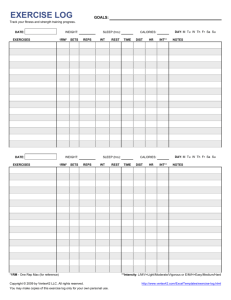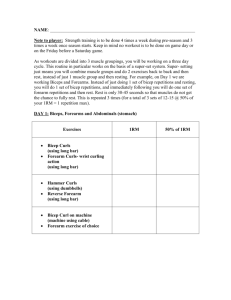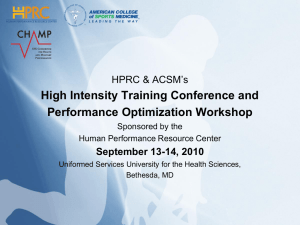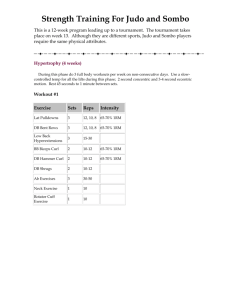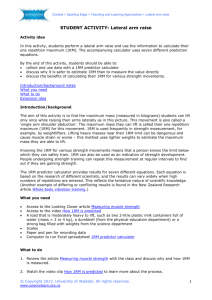Palm Cooling Delays Fatigue during High
advertisement
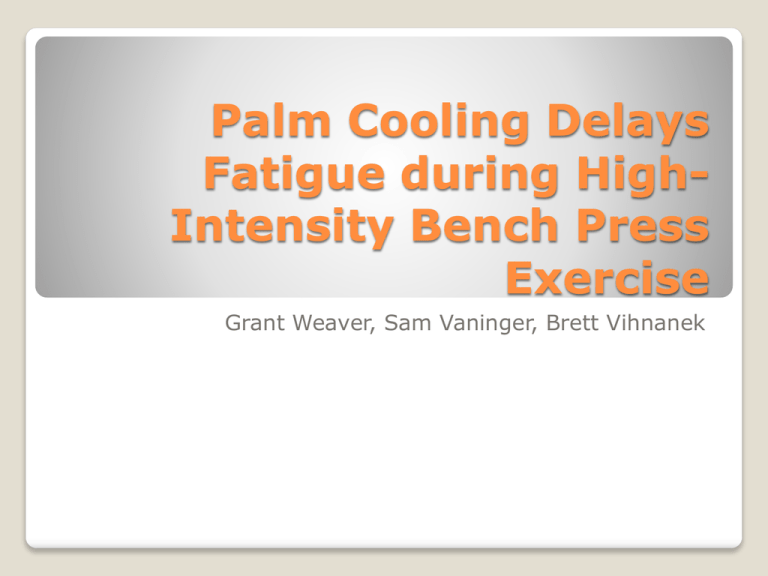
Palm Cooling Delays Fatigue during HighIntensity Bench Press Exercise Grant Weaver, Sam Vaninger, Brett Vihnanek The purpose of this study was to test whether or not local palm cooling (PC) during rest intervals between progressive weight training sets will increase total repetitions and exercise volume in resistance trained subjects exercising in a thermoneutral environment. Hypothesis was that palm cooling would increase total reps and total volume lifted Purpose Sixteen healthy male subjects (mean: 26, SD +/- 6 yrs) Volunteers Had participated in regular, intense weight training for a minimum of 5 years Ratio of weight pressed during bench press was more than 80% of age based upper body strength. All screened for cardiovascular and musculoskeletal diseases. Instructed not to exercise the day before a trial, to refrain from caffeine ingestion, to follow their normal diet, and to eat a light meal 2 hours before coming to the lab. Subjects Subjects familiarized with testing protocol. Warm up of 10 reps at 50% of predicted 1 rep max (1RM), 5 reps at 70% of 1RM, 3 reps at 80% of 1RM, 1 rep at 90% of 1 RM Followed by 3 attempts to determine exact 1RM All subjects given 3 min rest between sets After 1RM was determined, subjects were given a 5 min rest period and then completed as many reps as possible at 85% of 1RM Position of little finger on bar was marked for each subject, so each subject performed lift the exact same way in each of their trials Procedure: Day 1 3 different treatments: Palm heating (PH), Palm cooling (PC), thermoneutral (TN) Heating and cooling was induced by placing a rapid thermal exchanger (RTX) on each hand. Works by creating seal around the wrist and pulling air out of the device, creating negative pressure. Water temperature in device was 10 C during cooling and 45 C during heating. For the TN trials, hand was placed in RTX with negative pressure but no hot or cold water was applied Procedure: Treatment explanation Each subject warmed up in the exact same way they did on day one, finishing their warm up with their 1RM After another 5 min of rest, 4 sets of 85% of 1RM were performed until fatigue 1st set: 85% of 1RM Procedure: Testing days 2,3,4 2nd, 3rd 4th sets: The subjects all were then given each treatment (PC, PH, TN) on these sets 15 seconds transition, 2.5 min of treatment, 15 sec transition in between each trial Counterbalanced design so that each subject experienced the treatments in different orders on each day All tests were performed at the same time of day for each subject 3 days of rest given in between each test Procedure (cont) Total Exercise Volume for all sets: PC mean: 2480 +/- 636 kg PH mean: 2156 +/- 668 kg TN mean: 1972 +/- 632 kg Total reps per set: PC mean: 5.9 +/- 2.1 PH mean: 5.1 +/- 1.1 TN mean: 4.7 +/- 2.2 It is clear that palm cooling increased total volume lifted as well as total reps performed. The differences in TN and PH were considered statistically insignificant in the study Results Interaction of selection and treatment: The study only concerned healthy resistance trained subjects, and that is who was tested, so it is safe to generalize. Interaction of setting and treatment: Tests were all done in a thermoneutral environment. Most bench pressing would be done in this sort of environment, so this was not a threat. Interaction of history and treatment: All subjects performed their tests at the same time of day each time, so this is not a threat. External Validity IV: Palm temperature (PC, PH, TN) DV: Number of reps, total volume lifted The rapid thermal exchanger is an effective way to regulate palm temperature The study only concerned bench press and palm temperature, and both were measured and performed pretty much perfectly to our understanding. Further increasing the temp in the RTX for palm heating and further decreasing the temp for palm cooling may have produced different results, but from the results of the experiment it seems they would only further prove the results already obtained. Construct Validity A counterbalanced study design was used Each subject experienced all the treatments each day. Each day the order in which they received the treatments was altered to minimize learning or order effects. None of the threats to internal validity seemed to apply here, as all the subjects had full knowledge of the experiment. They weren’t really separated into any groups, they all underwent multiple treatments. Internal Validity The experimental design of this experiment was set up in a way which seemed to eliminate any threats to validity We found that this study had extremely good validity across all 3 types, and therefore the results appear to be very valid Conclusion
